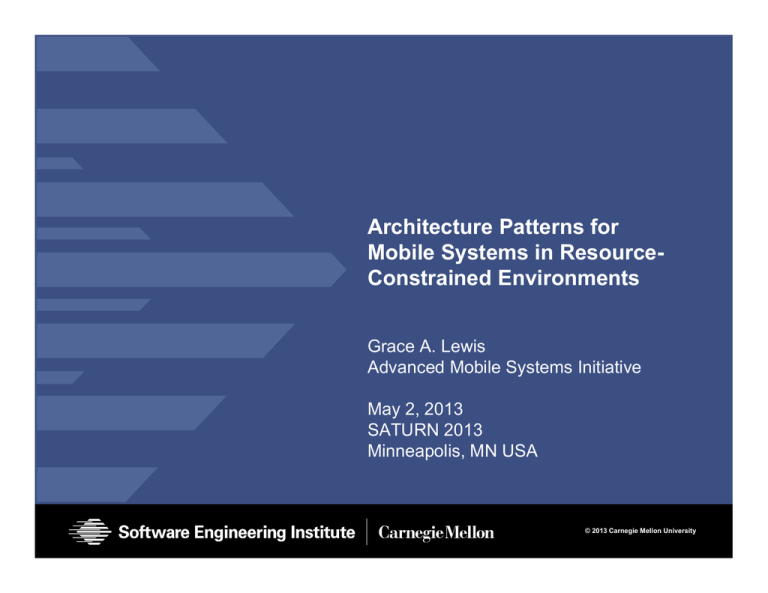Architecture Patterns for Mobile Systems in Resource- Constrained Environments Grace A. Lewis
advertisement

Architecture Patterns for Mobile Systems in ResourceConstrained Environments Grace A. Lewis Advanced Mobile Systems Initiative May 2, 2013 SATURN 2013 Minneapolis, MN USA © 2013 Carnegie Mellon University Motivation First responders, soldiers and other front-line personnel operate in resource-constrained environments characterized by • • • • • intermittent or no connectivity to traditional infrastructure; a fast-paced, highly-fluid and unpredictable environment; the potential of large amounts of raw data and information; resource challenges (i.e. power, computing, etc.); and periods of very high stress and cognitive load Mobile systems in these environments must • Provide situational awareness and data analysis even if disconnected from the enterprise • Reduce cognitive load and complexity, particularly in situations of high stress • Increase computing power, data access, and survivability of computing capabilities while reducing demands on person-carried resources Mobile Patterns at the Edge SATURN 2013 © 2013 Carnegie Mellon University 2 Architecture Patterns In software engineering, a pattern represents a proven solution to a recurring design problem • Gamma et al were the first to develop design patterns for object-oriented systems • Buschmann et al were the first to present architecture patterns for large-scale applications that could be composed to promote certain system qualities Architecture patterns have been developed for specific types of applications or domains, such as • • • • concurrent and networked systems enterprise applications distributed systems resource management This presentation focuses on architecture patterns for mobile systems that address the challenges of resource-constrained environments Mobile Patterns at the Edge SATURN 2013 © 2013 Carnegie Mellon University 3 Data Source Integration Pattern — Problem Motivation • Situational awareness (SA) applications in the field must support the rapid creation of mashups from multiple sources that might not be known in advance Problem • • • • Rapid incorporation of new data sources Minimized information overload User control of data sources, data volume and visualization Simple use Mobile Patterns at the Edge SATURN 2013 © 2013 Carnegie Mellon University 4 Data Source Integration Pattern — Solution Unified user interface User-defined data filters Data filtered on server before sending to client Server-side, separately defined data sources Data access via higherspeed and bandwidth connections Mobile Patterns at the Edge SATURN 2013 © 2013 Carnegie Mellon University 5 Group Context Awareness Pattern — Problem Motivation • Individuals at the edge operate cooperatively in teams • Crucial that every team member receives the right information at the right time in order to ensure their safety and effective actions Problem • Flexible enough to create, understand, and react to unpredictable events that were never imagined during planning • Resilient to intermittent communication and opportunistic in using communication access as it sporadically becomes available • Capable of managing mobile resources as efficiently as possible to maximize the availability of the system • Address cognitive load by providing mechanisms for supporting the information needs of the group while requiring minimal attention and interaction Mobile Patterns at the Edge SATURN 2013 © 2013 Carnegie Mellon University 6 Group Context Awareness Pattern — Solution Rule-based context engine determines resource utilization and information visualization Rule sets for different mission profiles Layered / MVC pattern Generalized control of sensors and communication mechanisms Group context data model Mobile Patterns at the Edge SATURN 2013 © 2013 Carnegie Mellon University 7 Cloudlet-Based Cyber-Foraging Pattern — Problem Motivation • Applications that are useful in resource-constrained, mission execution environments (e.g., face recognition, speech recognition) – require great amounts of battery and computing power – might not be able to execute on the mobile device due to the complexity of the code Problem • Cyber foraging is a technique to enable resource-poor, mobile devices to leverage external computing power by offloading code to surrogate • Most existing cyber-foraging solutions – Assume connectivity to the cloud – Tightly couple offloaded applications to the infrastructure Mobile Patterns at the Edge SATURN 2013 © 2013 Carnegie Mellon University 8 Cloudlet-Based Cyber-Foraging Pattern — Solution Paired application client and server Mobile Client Server 1 Offload Code Client App 1 Metadata Cloudlet Client Server 2 Offload Code Client App 2 Metadata Server n Offload Code CloudletReady Client App 1 Guest VM 1 CloudletReady Client App 2 Guest VM 2 CloudletReady Client App n Guest VM n Only infrastructure requirement is a VM manager Server 1 Resourceintensive server code executes in the cloudlet Server 2 Server n Server Offload Code + Metadata Cloudlet Metadata Cloudlet Server Client App n Metadata Discoverable Cloudlet Host VM Manager Cloudlet Metadata Discovery Service Legend Call System Boundary Custom Runtime Component 3rd Party Runtime Component File File Read/ Write Cloudlet located in single-hop proximity Broadcast VM-based promotes survivability via VM migration Can operate in disconnected mode Mobile Patterns at the Edge SATURN 2013 © 2013 Carnegie Mellon University 9 Current and Future Work We have implemented these architecture patterns using current technologies to demonstrate their technical feasibility Implementations have been taken to field experiments and operational exercises Currently working on the combination of these patterns to support context-aware, rapidly deployed SA solutions • Data Integration Server is rapidly deployed from a mobile device onto a cloudlet using Cloudlet-Based Cyber-Foraging • Group-Context-Awareness is used to tailor the information that is retrieved and visualized on each mobile device We are also working on additional architecture patterns to account for dynamic environments Mobile Patterns at the Edge SATURN 2013 © 2013 Carnegie Mellon University 10 Conclusions We presented a set of architecture patterns for mobile systems in resource-constrained environments to support personnel operating in edge environments Architecture patterns are driven by flexibility, resource efficiency, and usability which are key quality attributes for systems at the tactical edge Goal of these patterns is to enable system architects to instantiate them using a variety of technologies that can meet functional and quality requirements Mobile Patterns at the Edge SATURN 2013 © 2013 Carnegie Mellon University 11 Contact Information Grace A. Lewis Advanced Mobile Systems (AMS) Initiative Software Engineering Institute 4500 Fifth Avenue Pittsburgh, PA 15213-2612 USA Phone: +1 412-268-5851 Email: glewis@sei.cmu.edu WWW: http://www.sei.cmu.edu/staff/glewis/ Mobile Patterns at the Edge SATURN 2013 © 2013 Carnegie Mellon University 12 Copyright 2013 Carnegie Mellon University This material is based upon work funded and supported by the Department of Defense under Contract No. FA8721-05-C-0003 with Carnegie Mellon University for the operation of the Software Engineering Institute, a federally funded research and development center. NO WARRANTY. THIS CARNEGIE MELLON UNIVERSITY AND SOFTWARE ENGINEERING INSTITUTE MATERIAL IS FURNISHED ON AN “AS-IS” BASIS. CARNEGIE MELLON UNIVERSITY MAKES NO WARRANTIES OF ANY KIND, EITHER EXPRESSED OR IMPLIED, AS TO ANY MATTER INCLUDING, BUT NOT LIMITED TO, WARRANTY OF FITNESS FOR PURPOSE OR MERCHANTABILITY, EXCLUSIVITY, OR RESULTS OBTAINED FROM USE OF THE MATERIAL. CARNEGIE MELLON UNIVERSITY DOES NOT MAKE ANY WARRANTY OF ANY KIND WITH RESPECT TO FREEDOM FROM PATENT, TRADEMARK, OR COPYRIGHT INFRINGEMENT. This material has been approved for public release and unlimited distribution except as restricted below. This material may be reproduced in its entirety, without modification, and freely distributed in written or electronic form without requesting formal permission. Permission is required for any other use. Requests for permission should be directed to the Software Engineering Institute at permission@sei.cmu.edu. DM-0000348 Mobile Patterns at the Edge SATURN 2013 © 2013 Carnegie Mellon University 13





